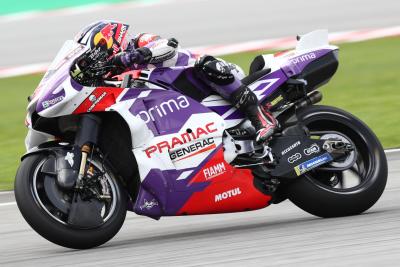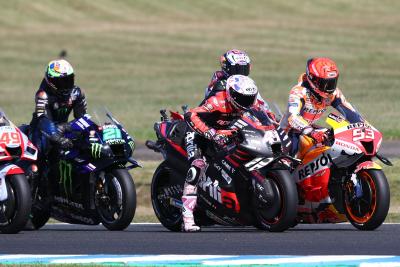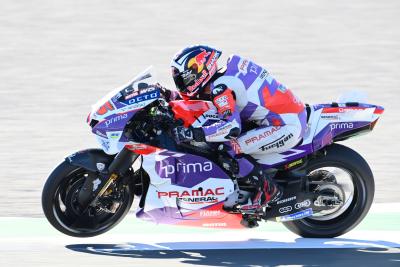Why 5 out of 6 manufacturers voted to ban front ride-height devices
The decision was announced in March last year, by which time Ducati - whose rear ride-height device had long been copied by the rest of the grid - was already testing a front system with its MotoGP race riders.
The manufacturers' association (MSMA) had been asked by the MotoGP organisers to consider two alternative proposals for the future of ride-height devices, which had the aim of ‘preventing further performance improvements and development cost increases.’
Although the MSMA subsequently approved a front ride-height ban from 2023, a clear split emerged between Ducati - having already invested time and resources in developing the front system - and the other five manufacturers.
Rear ride-height devices, aiding acceleration on corner exit, will continue to be legal this season as well as ‘single use’ front holeshot devices for the start of a race…
Ducati: ‘Instead of trying to catch up, it’s easier to ban’
Davide Barana, Ducati Corse technical director: “I don’t like to talk too much about this because you know what happened.
“We were the first to introduce the [rear holeshot] system for the start, the others followed. So then we developed the second step, to lower the [rear] during operation, and the others followed.
“The next step was to expand these capabilities to the front of the bike also.
“At a certain point someone came up with a proposal to ban this kind of device. It was clear it was already being used by one manufacturer, Ducati. Ducati declared to the others, ‘hey, I’m using this device you are going to ban’. Five manufacturers out of six decided to ban it.
“What I’d say is that the five manufacturers just exercised their rights. Everything was within the rules. They did not ‘steal’ anything. But if I look back on this story, I can say that it has not been a very nice display of fairness at all.
“Because instead of trying to catch up to develop your bike, it’s much easier to ban.”
Yamaha: ‘This request came from the organiser’
Kazutoshi Seki, Yamaha MotoGP project leader: “Looks like Ducati is not happy, but my understanding is this request came from the organiser. Then we considered all the factors and then we agreed to the proposal. This is my understanding.”
Aprilia: ‘Ban all of them as soon as possible’
Romano Albesiano, Aprilia technical director: “Our general thoughts about these devices is to possibly ban all of them as soon as possible. It’s just a complication. Something that will never reach production.
“These [mechanical and hydraulic] ride height devices have been forced by the regulations. Because if you want to do a ride-height device on a normal bike you would use a different [electronic] technology, that you cannot use in MotoGP because of the regulations.
“We were the first manufacturer to introduce the front holeshot device, for the start, but anyway our philosophy is to avoid this kind of development that we believe is not useful to production bikes.”
KTM: ‘Safety is a big concern’
Sebastian Risse, KTM MotoGP technical manager: “We believe that we are going faster and faster and it comes to a point where safety is a big concern. We see there is a correlation between [speeds and] technology like this and aerodynamics, and for that reason we opted to ban what we can ban.
“We understand from the sporting side it’s very difficult when a technology is already implemented. In the beginning, when this topic was raised, I think the people that brought it up were not aware [Ducati already had a front system].
“[So] we also had to find a solution to give Ducati some time to take advantage of it before it is banned and I think finally we found a fair trade-off [by allowing the front system until the end of 2022].
“I also agree with Aprilia that the ride height device technology is actually behind what could be implemented on a street bike [because the MotoGP regulations ban electronic ride-height systems].”
Honda: ‘Normal to have different opinions, procedure was fair’
Takeo Yokoyama, HRC technical manager: “We always discuss things peacefully within the MSMA, but I think with six manufacturers it’s normal to have different opinions. The topic was put on the table by the organiser. We made a fair discussion.
“In our case, as Honda, we made some studies and thought this is not going to be implemented in street bikes in future, which is one of the big reasons HRC goes racing.
“So we voted to ban, as proposed by the organiser. It was 5 to 1 and so it was decided. The procedure was fair enough. As Honda we always stay to our philosophy, which includes, is it possible to implement [a technology] on street bikes or not?”
Suzuki: ‘This technology is too far from the production bike’
Suzuki technical manager Ken Kawauchi was also part of the vote, since it was made before the factory's shock decision to quit MotoGP at the end of 2022: “We had a similar opinion as Aprilia. One target of our participation in MotoGP is to improve our production bikes and at the moment this technology is too far from the production bike, so not so much meaning [to use it].”
The rider’s viewpoint…
Unfortunately for Ducati, the one-season grace period before the ban came into force wasn’t long enough to generate a clear advantage from the new front ride-height system.
While Francesco Bagnaia won the title without it, Pramac’s Johann Zarco persisted with the technology for much of the year in the hope of finding an edge.
“We analysed and I couldn’t really get the advantage from it, even after a whole season of work on it,” Zarco said at the Valencia finale. “We said it’s better to be like the others and prepare myself for next year [without it].
“The front [lowering] makes a big difference at the start but when you’re riding it makes the bike work differently. I was pushing to keep using it because it was good to do this with Ducati, but since we won’t use it next year, we decided to say, ‘OK, we didn’t get that advantage’.
“In the winter tests, I’ll have time to get used to the normal [front fork] again.”





![Johann Zarco, LCR, Honda RC213V, 2024 San Marino MotoGP, Misano, action [Gold & Goose]](https://cdn.crash.net/styles/thumbnail/s3/2024-09/GnG_1166323_HiRes.jpg?itok=vpgrU7Q4)

![Jack Miller, KTM Factory Racing, KTM RC16, San Marino MotoGP, Misano, action [Gold & Goose]](https://cdn.crash.net/styles/thumbnail/s3/2024-09/GnG_1167624_HiRes.jpg?itok=iz7mA4EQ)


![Fabio Quartararo, Monster Energy Yamaha Racing, Yamaha M1, 2024 MotoGP, Misano Test, action [Gold & Goose]](https://cdn.crash.net/styles/thumbnail/s3/2024-09/GnG_1168928_HiRes.jpg?itok=fcYSole_)
![Toprak Razgatlioglu, ROKiT BMW Motorrad, BMW M 1000 RR, Magny-Cours, WorldSBK [Gold & Goose]](https://cdn.crash.net/styles/thumbnail/s3/2024-09/GnG_1165133_HiRes.jpg?itok=GD5SVNVG)

